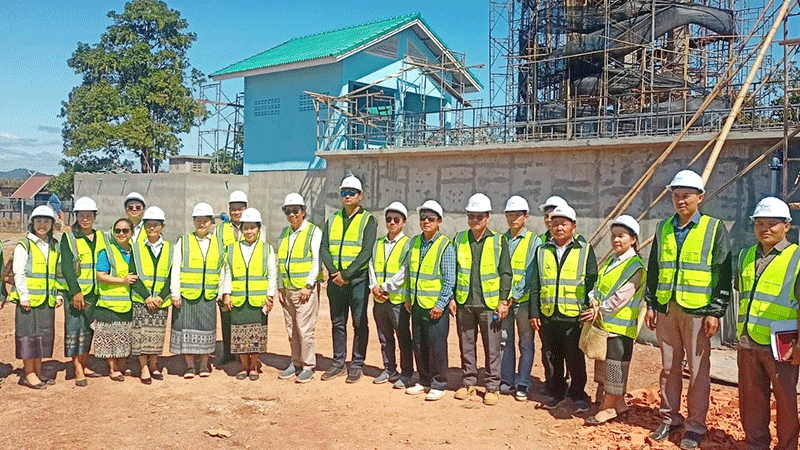 |
| Building climate-resilient water supply infrastructure in Sethamouk Town, Savannakhet Province, through a partnership between the local government and UN-Habitat. |
Shaping Laos’ urban settlements: Turning Crises into Opportunities for Resilience
Globally, urban crises are becoming the new normal, but they can also be the turning points that decide whether our cities crumble or emerge more resilient.
Every year on the first Monday of October, World Habitat Day reminds us that while it began as a call for the universal right to shelter, it has grown into a global moment to reflect on the state of our towns and cities, and the urgent task of shaping them to be inclusive, resilient, and sustainable. Thus, this year’s theme, Urban Crisis Response, is especially timely for Laos.
Urban climate disasters cost the world US$250 billion last year, with annual losses projected to reach US$314 billion by 2030. Heat-related deaths could double by 2050 without urgent investment in resilience. Yet resilience is not only about withstanding shocks, it is also about unlocking opportunity. A resilient city is a thriving city, capable of closing inequality gaps and creating a future that is more equitable, sustainable, and vibrant.
The Lao Reality: Repeated Crises, Rising Costs
Laos has faced more than 30 major disasters in the past two decades, mostly floods and storms, affecting over 4.3 million people and causing nearly US$600 million in damages. A study conducted in 2020 by the then Ministry of Natural Resources and Environment (now the Ministry of Agriculture and Environment), together with UN-Habitat, showed that nearly half of Laos’ population is exposed to at least one or more climate-induced hazards such as floods and droughts annually. This year’s floods alone, to date, caused losses of more than US$115 million across the country and affected 327,611 people.
These numbers conceal human struggles: families in Luang Prabang rebuilding schools washed away, farmers in Huaphan replanting lost harvests, and communities in Xiengkhouang struggling to restore water systems. Disasters do not strike evenly; they deepen existing inequalities, particularly for women, persons with disabilities, youth, and low-income households in rapidly urbanising towns. As we know, Laos is urbanising at a high rate of 4.5 percent annually, which will increasingly place mounting pressure on housing, land, and the provision of basic services.
From Relief to Resilience
The cycle of disaster-response-recovery is no longer sustainable. In Laos, where climate extremes and natural hazards are intensifying, the cost of waiting until disaster strikes is already too high. The Government’s National Strategy on Disaster Risk Reduction 2021-2030 rightly calls for a shift from reactive response to proactive resilience. To achieve this, three areas demand urgent attention.
To start with, resilience must be both social and economic. Investing in vulnerable communities and diversifying local economies reduces risk and dependency, while global evidence shows that every US$1 spent on resilience saves an estimated US$4 in post-disaster losses. For Laos, such investments are both a moral obligation and an economic imperative.
Equally important is environmental and infrastructure resilience. Green zones in Vientiane can lower peak urban temperatures by as much as 4°C, and permeable pavements in Pakse could absorb 70 percent more stormwater. At the same time, resilient housing, drainage, and water supply systems are not luxuries; they are lifelines for survival in a warming, flood-prone world.
Finally, governance and community engagement determine whether national strategies succeed. Laws such as the Disaster Management Law enacted in 2019 provide the backbone, but resilience will ultimately be built through empowered communities, strengthened institutions, and inclusive participation that brings policy into practice at the local level.
Laos has the tools, the knowledge, and the mandate. The challenge now is to act decisively: breaking free from the endless cycle of disaster and response, while focusing on and building on a future rooted in resilience.
The upcoming 4th Lao National Urban Forum, to be held this year in Vientiane on October 6 and in Pakse on October 17 under the theme “Urban Crisis Response”, will bring together youth, communities, and policymakers to turn resilience into a shared national agenda.
Towards a Future-Proofed Lao City
Urban crises need not be permanent setbacks. With the right investments, they can be turning points. For example, UN-Habitat is working with Lao authorities to integrate climate risk and hazard mapping into urban planning, thus ensuring that cities grow with risk awareness built into their very fabric.
Furthermore, in Pakse and Kaysone Phomvihane, city leaders are exploring low-emission urban development strategies, linking mobility, energy use, and land planning to greener growth. In flood-prone areas, initiatives are supporting resilient housing infrastructure and the piloting of ecosystem-based solutions such as urban wetlands and green corridors to buffer communities from stormwater and heat extremes. These are not abstract ideas, but they are concrete examples of how resilience can transform crisis into opportunity.
Solidarity in a Shared Region
Laos is not alone. Regional cooperation, through the ASEAN Coordinating Centre for Humanitarian Assistance (AHA Centre), reinforces the principle of One ASEAN, One Response. The Inter-Agency Standing Committee, jointly led by the United Nations and the Government, supports the Government’s efforts on disaster preparedness and response. But effective crisis response begins at home with empowered provincial, district, and village disaster committees, functioning inclusive early warning systems, and sustainable financing that ensures resources reach those most at risk.
Resilience as a Choice
World Habitat Day 2025, celebrated on October 6 this year, reminds us that resilience is not just about bouncing back; it is about bouncing forward. For Laos, the choice is stark but hopeful: invest in resilience now, rather than paying many times more in losses later. The future of Laos’ cities and towns will not be defined by the crises they endure, but by how they rise beyond them.
By Bakhodir Burkhanov, Resident Coordinator, UN Lao PDR
Avi Sarkar, Head of Office UN-Habitat and Regional Advisor SEA, UBS, UN-Habitat
By Times Reporters
(Latest Update October 6, 2025)
|


